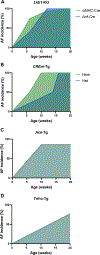Mouse models of spontaneous atrial fibrillation
- PMID: 36173465
- PMCID: PMC10898345
- DOI: 10.1007/s00335-022-09964-x
Mouse models of spontaneous atrial fibrillation
Abstract
Atrial fibrillation (AF) is the most common arrhythmia in adults, with a prevalence increasing with age. Current clinical management of AF is focused on tertiary prevention (i.e., treating the symptoms and sequelae) rather than addressing the underlying molecular pathophysiology. Robust animal models of AF, particularly those that do not require supraphysiologic stimuli to induce AF (i.e., showing spontaneous AF), enable studies that can uncover the underlying mechanisms of AF. Several mouse models of AF have been described to exhibit spontaneous AF, but pathophysiologic drivers of AF differ among models. Here, we describe relevant AF mechanisms and provide an overview of large and small animal models of AF. We then provide an in-depth review of the spontaneous mouse models of AF, highlighting the relevant AF mechanisms for each model.
© 2022. The Author(s), under exclusive licence to Springer Science+Business Media, LLC, part of Springer Nature.
Conflict of interest statement
Figures


References
-
- Adam O, Frost G, Custodis F, Sussman MA, Schafers HJ, Bohm M, Laufs U (2007) Role of Rac1 GTPase activation in atrial fibrillation. J Am Coll Cardiol 50(4):359–367 - PubMed
-
- Anne W, Willems R, Holemans P, Beckers F, Roskams T, Lenaerts I, Ector H, Heidbuchel H (2007) Self-terminating AF depends on electrical remodeling while persistent AF depends on additional structural changes in a rapid atrially paced sheep model. J Mol Cell Cardiol 43(2):148–158 - PubMed
-
- Avula UMR, Hernandez JJ, Yamazaki M, Valdivia CR, Chu A, Rojas-Pena A, Kaur K, Ramos-Mondragon R, Anumonwo JM, Nattel S, Valdivia HH, Kalifa J (2018) Atrial infarction-induced spontaneous focal discharges and atrial fibrillation in sheep: role of dantrolene-sensitive aberrant ryanodine receptor calcium release. Circ Arrhythm Electrophysiol 11(3):e005659. - PMC - PubMed
-
- Avula UMR, Dridi H, Chen BX, Yuan Q, Katchman AN, Reiken SR, Desai AD, Parsons S, Baksh H, Ma E, Dasrat P, Ji R, Lin Y, Sison C, Lederer WJ, Joca HC, Ward CW, Greiser M, Marks AR, Marx SO, Wan EY (2021) Attenuating persistent sodium current-induced atrial myopathy and fibrillation by preventing mitochondrial oxidative stress. JCI Insight 6(23):100 - PMC - PubMed
-
- Benjamin EJ, Muntner P, Alonso A, Bittencourt MS, Callaway CW, Carson AP, Chamberlain AM, Chang AR, Cheng S, Das SR, Delling FN, Djousse L, Elkind MSV, Ferguson MV, Fornage M, Jordan LC, Khan SS, Kissela BM, Knutson KL, Kwan TW, Lackland DT, Lewis TT, Lichtman JH, Longenecker CT, Loop MS, Lutsey PL, Martin SS, Matsushita S, Moran AE, Mussolino ME, O'Flaherty M, Pandey A, Perak AM, Rosamond WD, Roth GA, Sampson UKA, Satou GM, Schroeder EB, Shah SH, Spartano NL, Stokes A, Tirschwell DL, Tsao CW, Turakhia MP, VanWagner LB, Wilkins JT, Wong SS, Virani SS, E. American Heart Association Council on, C. Prevention Statistics, S. Stroke Statistics (2019) Heart Disease and Stroke Statistics-2019 Update: A Report From the American Heart Association. Circulation 139(10):e56–e528. - PubMed
Publication types
MeSH terms
Grants and funding
LinkOut - more resources
Full Text Sources
Medical

